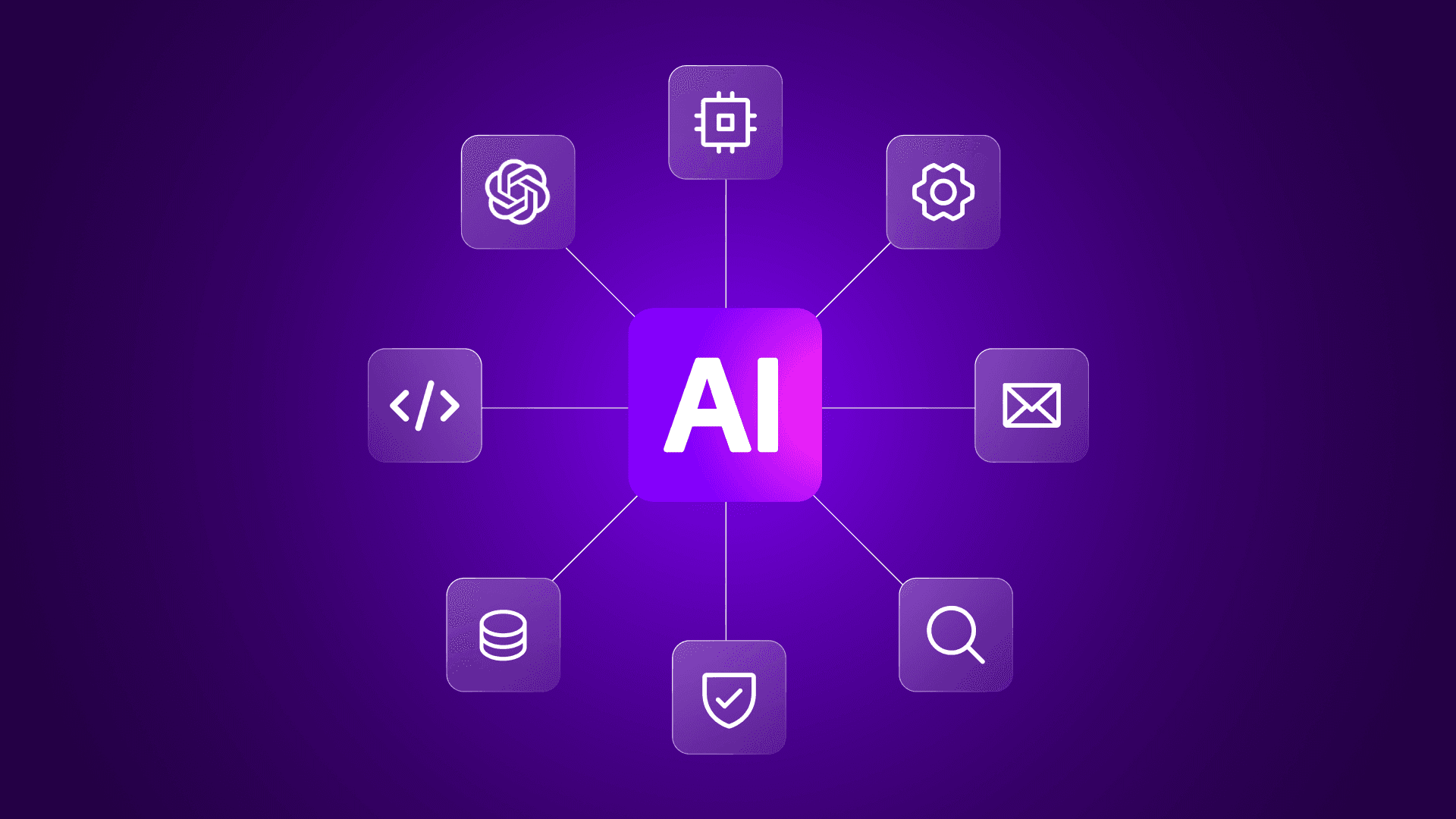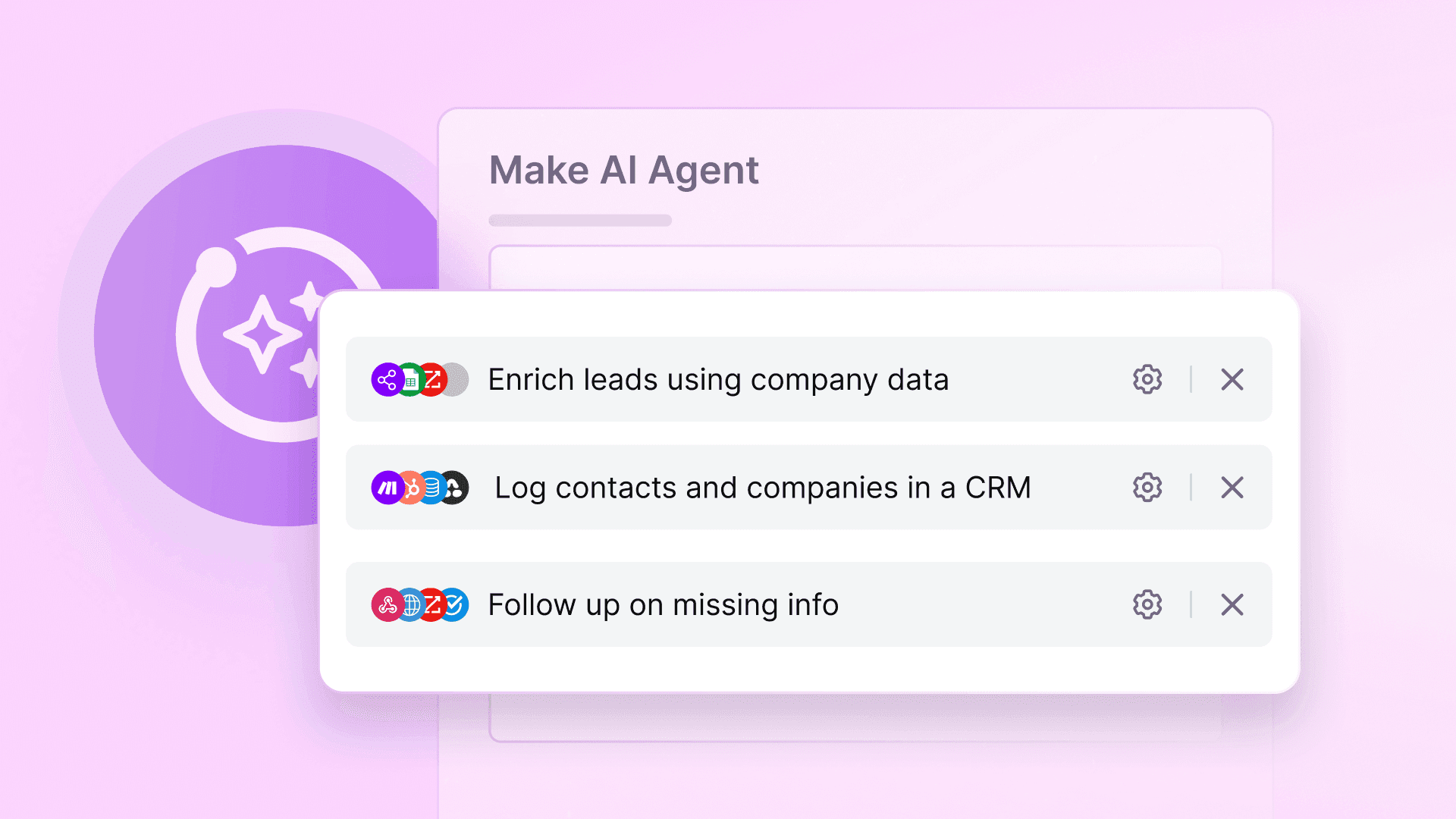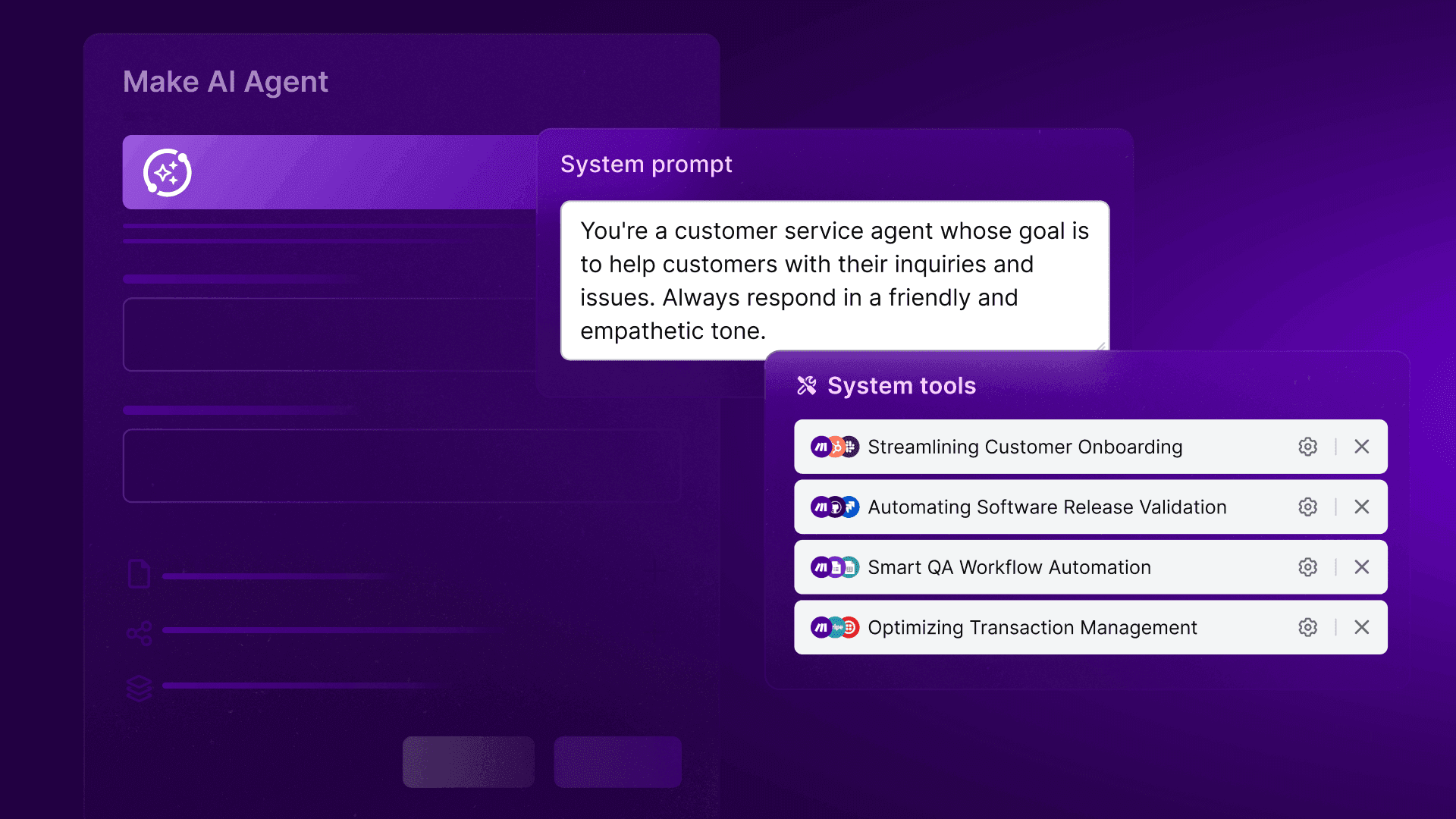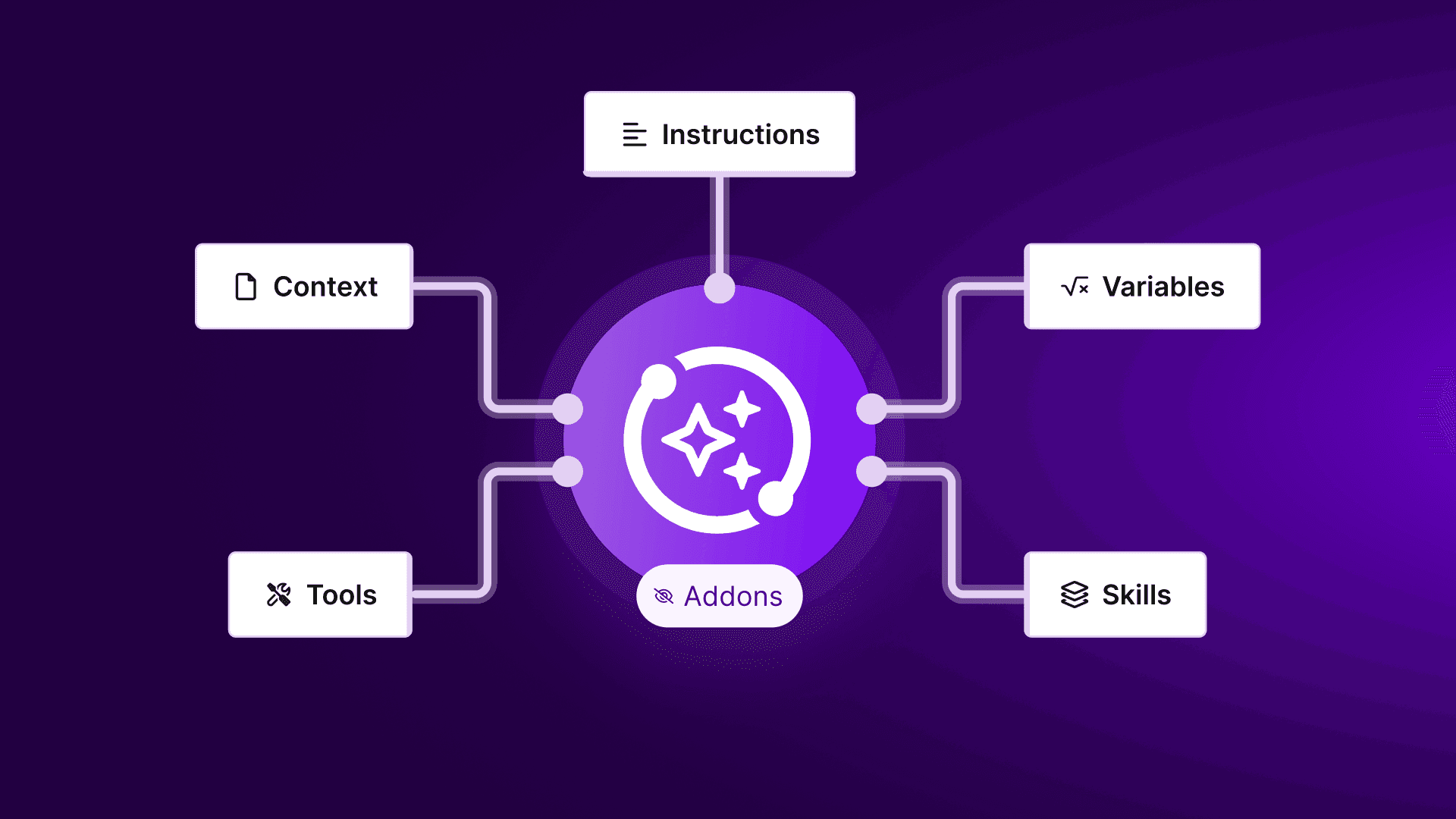May 5, 2025 | 6 minutes
What is agentic AI?
Agentic AI enables systems to perceive, reason, act, and learn with minimal human input. Learn how it differs from traditional automation and how Make is bringing this next-generation technology to business workflows.

Imagine having an assistant that carries out the tasks you instruct it to do perfectly. It assesses the task at hand, determines the best approach for getting it done, and then works independently to make this happen. It’s a fast worker, typically completing tasks within seconds, and also gets better at its job over time.
Then, imagine having an army of these assistants, performing dozens or even hundreds of tasks in this way. Wouldn’t it revolutionize how your business operates?
That’s the power of agentic AI — which is available, at your fingertips, with a Make account.
At Make, we’re constantly pushing the boundaries of improving workplace productivity so that businesses can effortlessly automate and scale their workflows. This includes offering cutting-edge agentic AI functionality that will spark the next evolution in AI automation.
Here’s an explainer on what agentic AI is, why it’s a big deal, and how to incorporate it into your business processes with Make.
What is agentic AI?
Agentic AI is the ability of AI software programs to make decisions and act independently — in other words, with agency — to achieve its assigned goals.
Let’s say we have an agentic AI chatbot whose job is to satisfactorily address customers’ ecommerce order queries. To do this, it may need to:
Get a holistic understanding of the customer’s query,
Assess an appropriate solution,
Check the customer’s order history, and then
Generate a comprehensive and relevant response based on its findings.
And it does all this independently, with minimal human input.
In contrast, a non-agentic AI system may have less ability to tailor its responses to match the situation.
For instance, a non-agentic customer chatbot that provides scripted replies in response to certain keywords may give irrelevant answers if the customer has used multiple conflicting keywords in their query.
Agentic AI vs AI agents
AI agents are the AI-powered software programs we deploy to achieve various objectives.
Agentic AI refers to the ability of AI software programs to act independently.
In this way, we can have agentic AI agents as well as non-agentic AI agents, with agentic ones being able to make decisions more autonomously than their non-agentic counterparts.
Agentic AI vs generative AI
Generative AI is an AI field that uses models to produce content, like text, images, videos, and an agentic AI system may tap into generative AI capabilities to complete its objectives if it determines this is necessary.
For example, an agentic AI chatbot may use generative AI technology to craft tailored responses to customers’ queries.
How does agentic AI work?
Agentic AI systems work via a four-stage process of perceiving, reasoning, acting, and learning:
Perceiving: The agentic AI system collects information from sources available to it — similar to how we use our senses to become aware of our environment. Depending on what the AI system is used for, these sources can include chat histories, style guides, and financial reports.
Reasoning: Next, the agentic AI system evaluates how to best achieve the required outcome, identifying related issues that need addressing along the way. For example, the AI system might reason like this: “To create a thought leadership-style blog post on vibe coding, I need to define and apply the key characteristics of a thought leadership writing style.”
Acting: The agentic AI system carries out the actions it has determined it needs to do. In the process, it may tap into integrations that trigger other apps to execute the required actions. These integrations may be coded from scratch or built using a no-code integration platform like Make.
Learning: Last but not least, the agentic AI system compares the results of its efforts against the desired outcome and updates the way it executes future tasks — like adjusting its algorithms, for example.
The benefits of working with agentic AI
By working with agentic AI, you stand to:
Speed up your decision-making: Agentic AI systems can suggest solutions to complex issues within seconds.
Automate your workflows: Through app integrations, agentic AI systems can automate entire workflows, executing them with minimal to no human intervention when the right trigger events occur.
Scale your processes effortlessly: Agentic AI systems can execute tasks much quicker than humans, helping you contact more prospects, churn out more reports, respond to more customer queries, and more, in the same amount of time.
Enjoy cost savings: Outsourcing tasks to agentic AI systems — and having your staff oversee them — means your team can do more with the same amount of resources. This saves you money from hiring more staff to reap the same results.
Agentic AI examples
The independent nature of agentic AI makes it a natural candidate for powering automations — especially sophisticated ones involving more decision-making.
So, enter agentic automation: the automation of workflows using agentic AI systems that can assess the situation presented to them, reason on the steps to take, and then execute them autonomously.
Here are some ways you can apply agentic automation in your organization:
Marketing: Repurpose blog posts into promotional social media posts, evaluate user sentiment toward social content and generate responses to comments, and produce detailed marketing reports combining data from multiple sources. Manage email unsubscribers, campaigns, and content creation.
Operations: Manage cross-functional projects, generate contracts, and send alerts when inventory levels drop below certain prescribed quantities.
Finance: Process supplier invoices, conduct real-time fraud transaction monitoring, and budget for organizational spend.
Customer service: Deploy intelligent chatbots that can expertly handle customer support queries, evaluate customer satisfaction survey results, and draft customer support articles that adhere to your organization’s tone of voice guidelines. Process incoming emails and determine if the ticket needs a reply, provide personalized responses and escalate to human agents when necessary.
Sales: Detect inbound leads, send personalized replies, enrich company data, handle missing info, and so on.
HR: Review CVs, automatically scan for potential candidates, and reach out with personalized emails. Onboard and offboard.
Logistics: In supply chain management, agentic AI elevates logistics operations by forecasting demand, overseeing inventory, and enhancing routing strategies. This leads to substantial reductions in waste and more effective resource allocation, driving improved operational efficiency and profitability.
Overcoming agentic AI limitations
While agentic AI systems can significantly enhance your operations, they have certain limitations. Be aware of these — and, more importantly, how to mitigate them:
Getting AI-generated content to sound like you: The content generated by agentic AI systems may not match your organization’s brand voice. Improve the output by feeding the AI system your style guide and content samples. This way, it can identify the unique traits of your organization’s tone of voice and apply them to its content.
Introducing human oversight to agentic AI systems: Letting agentic AI systems operate fully independently may limit your organization’s ability to take prompt remedial action if the system produces unsatisfactory outcomes (such as giving customers inaccurate information). If you’re building agentic AI scenarios in Make, consider adding the Human in the Loop app, which lets you send AI output for human review before it’s used in subsequent scenario steps.
Ensuring data security: If your agentic AI systems will process confidential business data, check that their technical infrastructure is designed to keep your data safe. At Make, we’ve implemented stringent data security measures, which you can learn about on our security and compliance page.
Get started with agentic AI
Agentic AI may be a fledgling technology, but interest in its potential is growing. As Deloitte predicts, 25% of organizations using generative AI tools will pilot agentic AI this year — with this percentage increasing to 50% by 2027.
If you aren’t part of this group of forward-thinking organizations yet, there’s no better time to join them.
From support for the world’s most popular AI apps to AI-powered scenario creation to AI tools, Make equips you with a host of AI solutions for building powerful agentic AI systems.
Sign up for a Make account to explore these!




